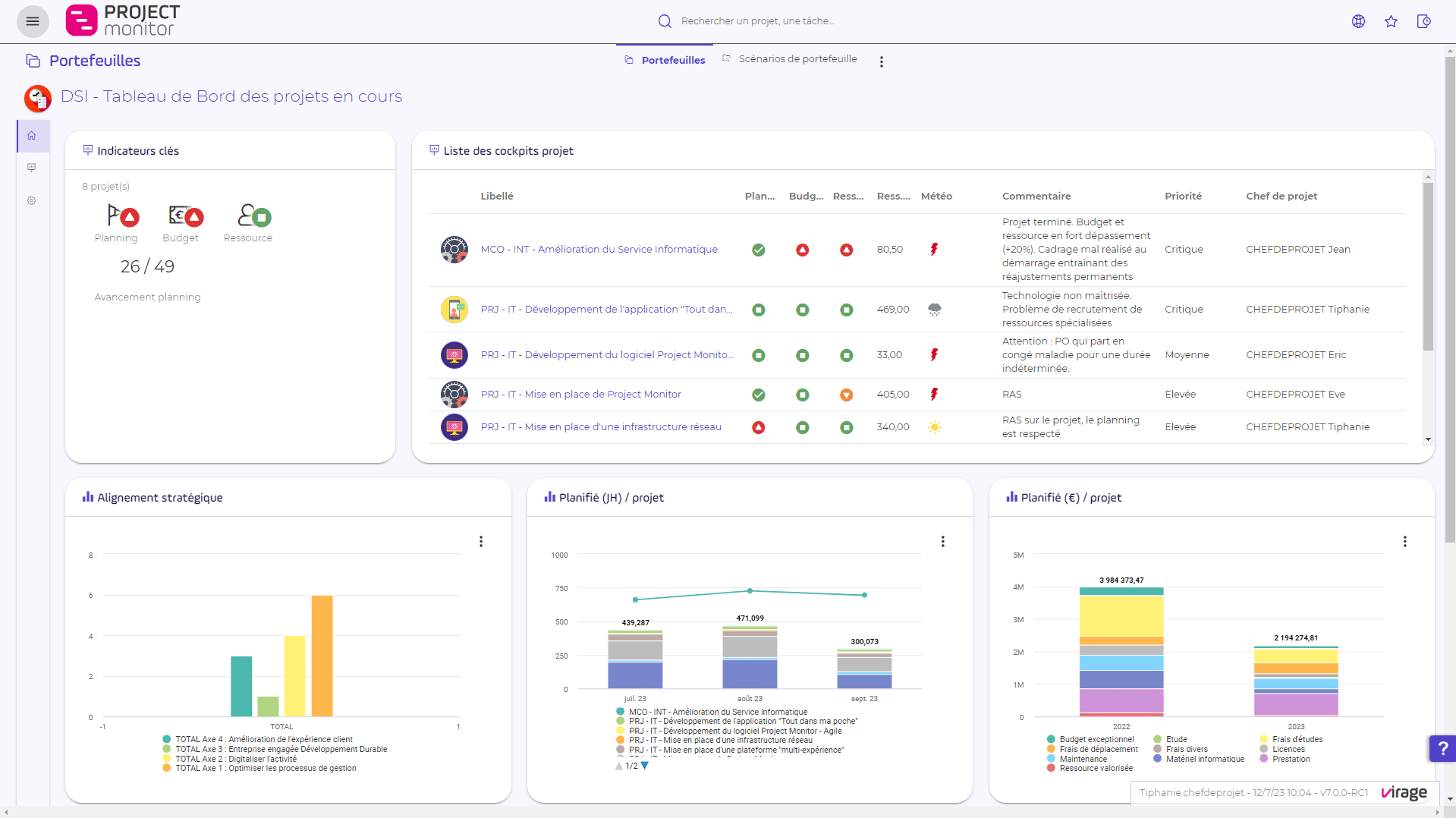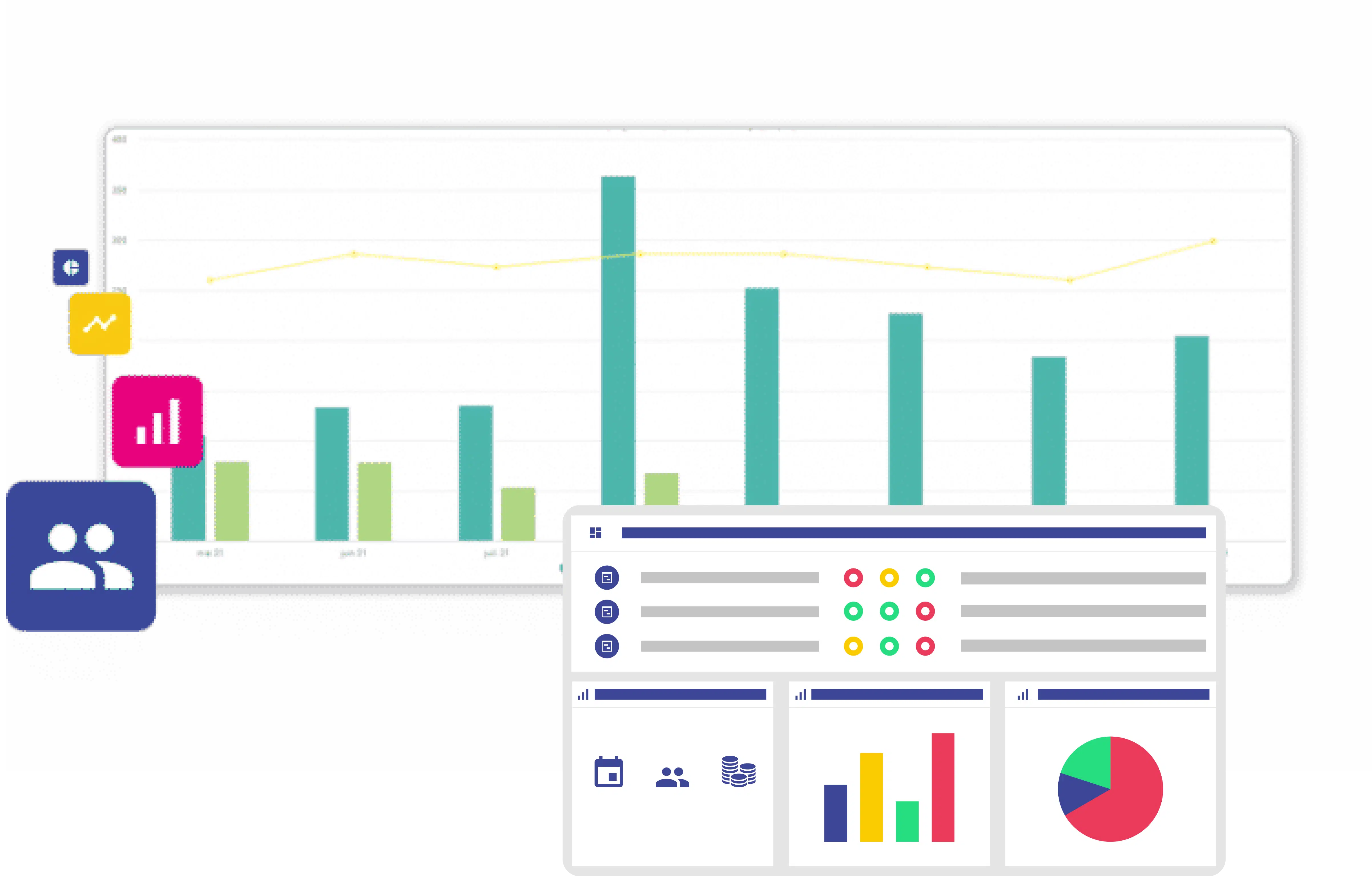Project portfolio review: the keys to facilitating your governance activities
The project portfolio review is one of the highlights of project mode governance. The project portfolio review is a key decision-making body that validates the launch of new projects, and decides on the allocation of resources and common resources for the various projects.
La revue de portefeuille de projets est un processus essentiel pour évaluer la performance globale, la cohérence et l’alignement stratégique des projets au sein d’une organisation. Elle consiste à examiner de manière systématique l’ensemble des projets d’un portefeuille, à évaluer leur état d’avancement, leurs résultats, leurs risques et leurs opportunités, ainsi qu’à prendre des décisions éclairées pour optimiser le pilotage du portefeuille. La revue de portefeuille permet de fournir une vision d’ensemble de la performance des projets, d’identifier les forces et les faiblesses, de prioriser les ressources, de réajuster les plans, et de garantir que les projets contribuent aux objectifs stratégiques de l’organisation. Grâce à la revue de portefeuille, les organisations peuvent améliorer la gestion de leurs projets, renforcer leur agilité et maximiser la valeur globale de leur portefeuille de projets.
Find out more in this article:
- The difference between a project review and a project portfolio review
- Steps in a project portfolio review
- Tools for a successful project portfolio review
What is a portfolio review?
The portfolio review is a process of systematic evaluation and analysis of all an organization's projects and initiatives.
It aims to assess the overall performance of the project portfolio, make strategic decisions and optimize resource allocation.
During the portfolio review, projects are evaluated according to predefined criteria such as :
- their strategic alignment,
- their advancement,
- their profitability,
- risk management, etc.
This review enables us to identify high-potential projects, pinpoint potential problems and adjust priorities to maximize the value and success of the entire project portfolio.
What's the difference between a project review and a project portfolio review?
Project review
- Scope: A project review focuses on the evaluation of a specific project, examining its performance, progress, conformity with objectives and compliance with constraints (budget, deadlines, etc.).
- Objective: The main objective of a project review is to obtain a detailed and specific view of the progress and management of an individual project, identifying emerging problems and taking corrective action where necessary.
- Participants : Participants in a project review are usually the project team, relevant stakeholders and the project's direct line managers.
Project portfolio review
- Scope: A project portfolio review assesses an organization's entire project portfolio. It examines overall portfolio performance, consistency between projects, strategic alignment, priorities, risks and opportunities.
- Objectif : L’objectif principal d’une revue de portefeuille de projets est de prendre des décisions éclairées sur le pilotage du portefeuille de projets, y compris la sélection, la priorisation, l’allocation des ressources et la réallocation des projets en fonction des objectifs stratégiques de l’organisation.
- Participants : Participants in a project portfolio review may include executive managers, department heads, project managers, project management experts and other strategic stakeholders.
Make the right decisions for your project portfolio
It is essential for your project portfolio reviews to :
- know all the projects in our portfolio
- list and prioritize requests for new projects
- consolidate all your project data in real time: progress, workload, budget allocation, etc.
- analyze your project portfolio according to your company's strategic priorities
- communicate with project beneficiaries (MOA) and project implementers (MOE)
- make data more reliable, since decisions will derive directly from project reporting
How to carry out a portfolio review
The portfolio review is an important process for assessing the overall performance of your project portfolio. Here are the key steps to an effective portfolio review:
- Define review objectives: Before starting the review, clarify the objectives you wish to achieve. This may include assessing project performance, identifying risks, optimizing resources, etc.
- Gather information: Collect all relevant information on each project in the portfolio, such as progress reports, performance indicators, schedules, budgets, etc. Make sure data is up-to-date and complete. Ensure that data is up-to-date and complete.
- Evaluate performance indicators: Analyze each project's key performance indicators to assess progress, profitability, on-time and on-budget performance, etc. Identify projects that stand out positively, and those that require special attention.
- Examine risks and problems: Identify potential risks and problems encountered in the project portfolio. Assess their impact on results and determine appropriate mitigation or resolution measures.
- Analyze strategic alignment: Assess the contribution of each project to the organization's overall strategy. Check whether projects are aligned with strategic objectives and priorities, and whether they add value.
- Monitor actions and corrective measures: Ensure that the actions decided at the portfolio review are implemented. Monitor their progress and evaluate their effectiveness in improving portfolio performance.
We recommend regular portfolio reviews, with a frequency adapted to your needs and the complexity of your project portfolio. This enables you to monitor project progress, adjust strategies in line with new information, and maximize the success of your portfolio.
Here's an example of a portfolio review dashboard covering key performance indicators (budgets, resources, progress).

What are the steps involved in a more detailed project portfolio review?
The project portfolio review is first and foremost an analysis of the key performance indicators (KPIs) within the portfolio. It is crucial for assessing overall performance and making informed decisions.
KPIs provide quantitative and qualitative measures of project progress, such as on-time delivery, on-budget delivery, quality of deliverables, stakeholder satisfaction, etc.
By analyzing these indicators, it is possible to identify problem projects, spot trends, compare performance between projects and highlight areas requiring particular attention.
By analyzing portfolio performance indicators, you can adjust priorities, allocate resources optimally and ensure that projects contribute to the organization's strategic objectives.
Some topics may be the subject of dedicated forums. Here is a general structure that can be used to conduct a more comprehensive project portfolio review as required:
Select projects for inclusion
Review the list of current and potential projects for the portfolio and select those to be evaluated.
To arbitrate on new project requests within a portfolio, it is essential to establish a clear prioritization process based on pre-established criteria. This process can include assessment of the request's strategic alignment with organizational objectives, analysis of the project's potential added value, assessment of risks and constraints, the organization's ability to carry out the project, and comparison with existing projects in the portfolio. Using these objective criteria, project requests can be compared fairly, enabling informed decisions to be made on which to accept, delay or reject, based on their overall contribution to the organization's strategy and objectives.
Analyze project risks
Project risk assessment is an essential step in project management. Project risk analysis consists of identifying, analyzing and evaluating potential risks that could affect the success of the project. This involves identifying sources of risk, estimating their probability of occurrence, assessing their impact on project objectives, and determining appropriate mitigation measures. By proactively assessing risks, the project team can anticipate potential obstacles, take preventive measures and develop contingency plans to minimize negative effects. Rigorous risk assessment improves decision-making, strengthens project resilience and promotes overall success.
Evaluate project progress
Assessing the progress of projects within a portfolio is essential for effective management. This involves regularly monitoring ongoing projects, examining their progress against targets, milestones achieved, tasks in progress and expenses incurred. By assessing progress, potential delays, deviations from forecasts and emerging problems can be identified. It also provides the opportunity to make any necessary adjustments, reallocate resources where necessary, and take corrective action to ensure successful project completion. By regularly assessing the progress of projects within the portfolio, it is possible to maintain an overall view of their performance, make informed decisions and maximize the overall value of the project portfolio.
Identify any resource imbalances or overloads
By ensuring a balanced distribution of resources, the organization can optimize the use of available resources, minimize resource conflicts and maximize the chances of success for the entire project portfolio. Managing the capacity of project resources within a project portfolio is essential to ensure efficient allocation of available resources. This involves assessing the resource demand for each project, identifying the skills and capabilities required, and planning their allocation in a balanced way. By managing resource capacity, it is possible to avoid overload or under-utilization, optimize project team productivity and minimize resource conflicts. Effective resource capacity management ensures that projects have the skills and resources they need to achieve their objectives, while maximizing the overall efficiency of the project portfolio.
What tools should you use to review your project portfolio?
There are several tools that can be used to carry out a project portfolio review. Here are a few commonly used examples:
- Portfolio dash board: Project portfolio dash boards enable you to view key portfolio performance indicators, such as project progress, budget expenditure, risks, allocated resources, etc.
- Risk assessment tools : Risk assessment tools help to identify, evaluate and manage the risks associated with the project portfolio. They enable risks to be monitored, their likelihood and impact to be estimated, and mitigation plans to be drawn up.
- Capacity schedule: Capacity schedule, or resource planning, is an essential tool for effectively managing the resources available within an organization. With a capacity schedule you can monitor the allocation of resources according to projects. Make sure that the most important and urgent projects are given priority, and that there is no over-staffing.
- Budget tracking tool: A tool for tracking budgets within a project portfolio is essential for effective financial management. This tool tracks spending and budget allocations for each project in the portfolio. It enables you to compare actual costs with initial estimates, detect variances and budget overruns, and take corrective action accordingly.
- schedule Gantt tool: A schedule tracking tool and Gantt chart for a project portfolio is a visual tool for creating, managing and tracking project schedules within a portfolio. This type of tool displays the tasks, dependencies, durations and milestones of each project in the form of a Gantt chart.
Vous pouvez centraliser ces outils au sein d’un logiciel de pilotage de portefeuille de projets (PPM) tel que Project Monitor. Les logiciels PPM offrent des fonctionnalités spécifiquement conçues pour le pilotage de portefeuille de projets. Ils permettent de centraliser les informations sur les projets, d’analyser les performances, de gérer les ressources, de prioriser les projets et de faciliter la prise de décision.
With Project Monitor :
- Access all project data entered directly into Project Monitor (activity data, schedule, budget, exchanges, etc.).
- Set up filters to navigate easily between projects of different status.
- Customized home pages tailored to your organization's needs.
- Get complete, up-to-date information on the progress of all the projects in your portfolio, so you can prepare your governance bodies as effectively as possible.
- The portfolio review slide show consolidates, standardizes and synthesizes all the data needed to animate governance bodies.
- Share portfolio review findings with relevant stakeholders, including line managers, project team members and strategic stakeholders.
🔎 To sum up,
Une revue de portefeuille de projets efficace peut être réalisée grâce à l’utilisation d’un logiciel de pilotage de portefeuille de projets.
This type of software offers advanced features for centralized information, real-time visibility and in-depth analysis of portfolio progress.
It facilitates the collection of up-to-date data, the evaluation of key performance indicators, the detection of discrepancies and potential risks, and informed decision-making.
Avec un logiciel de pilotage de portefeuille de projets, les revues de portefeuille deviennent plus efficaces grâce à la visualisation des données, la génération automatisée de rapports, la collaboration facilitée entre les parties prenantes et la gestion proactive des projets. Cela permet d’optimiser l’utilisation des ressources, de minimiser les risques et de maximiser les résultats pour assurer la réussite globale du portefeuille de projets.
Facilitate governance with Project Monitor
Simplify the management of your project portfolio with the project and portfolio review facilitation features of Project Monitor.

Other useful articles for Project Portfolio Review
Animation de la gouvernance

How to analyze project risks - Follow the guide! Examples of typical project management risks + the 4 steps of a risk analysis and management process.
Project portfolio dashboard
Autres questions fréquemment posées sur le pilotage de portefeuille projets :
What is a strategic portfolio review?
A strategic portfolio review is an in-depth assessment of all an organization's projects and initiatives, focusing on their alignment with the company's strategic objectives. The purpose of the review is to assess the relevance of projects to the organization's overall vision, to identify key projects contributing to the achievement of strategic objectives, and to adjust priorities where necessary. It enables informed decisions to be made on resource allocation, project selection and risk management, to ensure optimal strategic alignment of the portfolio.
Quelle est l’utilité du pilotage de portefeuille ?
le pilotage de portefeuille offre de nombreux avantages pour les organisations. Elle permet de regrouper, d’évaluer et de gérer l’ensemble des projets et initiatives sous un même ensemble cohérent. Une gestion efficace du portefeuille de projets permet de maximiser la valeur, de contrôler les risques et d’optimiser l’utilisation des ressources, conduisant ainsi à des résultats positifs pour l’organisation.
How do you manage a project portfolio?
To effectively manage a project portfolio, it is essential to implement a structured approach that includes project selection and prioritization, allocation of appropriate resources, regular progress monitoring, risk and issue management, and transparent communication with stakeholders. Periodic assessment of portfolio performance and adjustments based on results achieved are also necessary to ensure strategic alignment and overall success.
How do you build up a project portfolio?
Building a project portfolio involves several key steps. Identify potential projects in line with your organization's strategic objectives. Assess their relevance, feasibility and alignment with the overall vision. In this article, you'll find tips for building your project portfolio.
What are the project portfolio performance indicators?
These indicators may vary according to the organization's specific objectives and priorities, but some commonly used ones include return on investment (ROI), on-time delivery, budget compliance, stakeholder satisfaction, quality of deliverables, resource productivity and risk reduction. See this article for examples ofproject portfolio performance indicators.